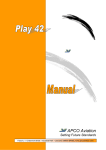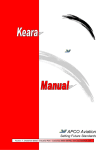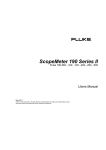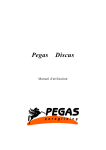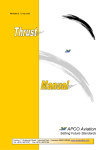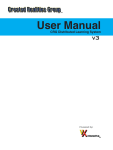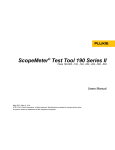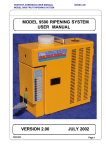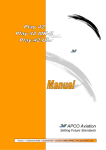Download Fiesta Tandem Manual
Transcript
APCO AVIATION USER MANUAL Fiesta Tandem INDEX Introduction Warning Disclaimer Construction & Materials Planform Total Line-Lenth Table Inspection & Maintenance First Check Pre-Flight Check RegularChecks Annual Checks Line Maintenance Trimming Preparing for Flight Harness & Spreaders Emergency Parachute Trim System Launch Layout Risers Front/Forward Launch Reverse Launch Tow or Winch Launch Flight Thermal Flying Asymmetric Collapse Front stall or Symmetric collapse B Stall Big ears Spiral Dives Steering not functioning Encountering Strong Turbulence Landing Tree Landing Water Landing Packing & General Advice Packing Cleaning amd Maintenance General Advice Introduction This glider is especially designed to meet the needs of the professional tandem pilot market. Any pilot looking for a wing which is safe, very easy to fly and can fulfill the requirements of professionals offering tandem rides and with the need to make a quick turn around with their passengers - need look no further! It is designed to have a very competitive price tag, making it affordable for tandem pilots. Fiesta Tandem does not replace the Futura Tandem, which will continue to be offered to free-flying pilots looking for performance and fun and wishing to take a ride with their friend. Warning This is not a training manual. It is extremely dangerous to yourself and others to attempt to fly this or any paraglider without completing a flying course given by a qualified instructor. The gliders are carefully manufactured and inspected by the factory. Please use the glider only as described in this manual. Do not make any changes to the glider. AS WITH ANY SPORT - WITHOUT TAKING THE APPROPRIATE PRECAUTIONS, PARAGLIDING CAN BE DANGEROUS. Disclaimer Taking into consideration the risk inherent in paragliding, it must be expressly understood that the manufacturer and seller do not assume any responsibility for accidents, losses, and direct or indirect damage following the use or misuse of this product. APCO Aviation Ltd. is engaged in the manufacture and sale of hanggliding, paragliding, motorised hanggliding, ultralite and emergency rescue equipment. This equipment should be used under proper conditions and after proper instruction from an experienced instructor. APCO Aviation Ltd. has no control over the use of this equipment and a person using this equipment assumes all risks of damage or injury. APCO Aviation Ltd. disclaims any liability or responsibility for injuries or damages resulting from the use of this equipment. The glider is designed to perform in the frame of the required class as certified by DHV. Construction & Materials The glider is constructed with a top and bottom surface that is connected by ribs. One top and bottom panel, together with the connecting rib is called a cell. Secondary ribs are of a diagonal design and sewn between the main ribs. Each cell has an opening on the front lower part. The cells fill with air forcing the panels to take shape, dictated by the airfoil (rib) section. On either side the wing ends in a stabiliser or wing tip which provides some straight-line stability and produces some outward force to help keep the canopy rigid. The glider is made from high tear resistant Ripstop Nylon cloth, which is P.U. coated to zero porosity and siliconized to give the fabric high resistance to the elements. Different cloth is used for the top, bottom and ribs due to their different functions. The front part of the ribs is made from Mylar to keep the leading edge shaped at high speeds and in turbulent air. It also improves the launch characteristics of the glider. The line hook up points are made of Dyneema and is imbedded in the sail for low drag attachment. The lines are made of superaramid covered with a polyester sheath for protection against wear and abrasion. The bottom section of the brake lines is made of polyester because of its better mechanical properties to resist bending around the steel ring of the brake line guide. The carabiners which attach the lines to the v-lines are made of high corrosion resistant stainless steel. First Check With every new glider, the following points should be checked: Connection points between the glider and the harness. That there are no twisted lines Brake line adjustment. All Apco gliders leave the factory with the brake lines set to its longest adjustment. Brake length is a personal setting and everybody has a different preference. Before the first the glider must be inflated to check and if necessary adjust the brake length to his or her preference. It is important that the brakes are not set too short. If the glider is above your head the brakes should not be pulling the trailing edge down as that means that the brakes are too short. A good setting is to have about 10 cm of slack in the brake from the brake guide on the riser to the activation point of the brakes. Pre-Flight Check Before each flight the following should be checked: All maillons between the lines and risers are closed All lines are intact and without signs of excessive wear or knots The canopy has no tears or damage on the top or bottom surface Regular Checks Damage to lines, webbing and thread on the stitching of the harness and v-lines. The pulleys of the speed system are free to move and not twisted. The condition of the brake lines, stainless steel ring and the security of the knot attaching the brake handle to the brake line. That the stainless steel carabiners on the v-lines are not damaged and are fully closed and covered with clear heat shrink to prevent them from opening in flight. The sewing and condition of the lines and connection of the lines. Damage to hook up points on the glider. Internal damage to the ribs and diagonal ribs. Damage to the top and bottom panels and seams between panels. Annual Checks It is mandatory for every Apco glider to be submitted for a annual check. In this check all the points in the sections above and below should be checked in addition to the ones listed here (below). If any points do not conform to the specifications given by Apco, the glider must first be repaired and approved .before it may be flown again. Porosity (of canopy fabric) Tear resistance (of canopy fabric) Line Strength Line Lengths Line Symmetry Integrity of line attachment Points Condition of risers Line Maintenance The Fiesta lines are made up of four groups meeting each riser. The four groups are called A, B, C and Brake lines. The stabilizer lines are connected with the B-lines. Superaramid lines are known to be sensitive to the influence of the elements. They must be carefully inspected periodically. In their own interest, the pilot must observe the following points to ensure maximum performance and safety from the glider. Avoid sharp bending and squeezing of the lines. Take care that people do not step on the lines. Do not pull on the lines if they are caught on rocks or vegetation. Avoid getting the lines wet. If they do dry them as soon as possible at room temperature and never store them wet. IT IS MANDATORY TO CHANGE THE BOTTOM LINES ON EVERY PARAGLIDER ONCE A YEAR OR EVERY 100 HOURS, WHICHEVER COMES FIRST. THE REST OF THE LINES MUST BE CHECKED YEARLY AND REPLACED IF NECESSARY. NEVER REPLACE THE LINES WITH DIFFERENT DIAMETER OR TYPE OF LINES AS ALL GLIDERS WERE LOAD TESTED FOR SAFETY IN THEIR ORIGINAL CONFIGURATION. CHANGING LINE DIAMETERS CAN HAVE FATAL CONSEQUENCES FROM LINE FAILURE TO STRETCH. Every six months one A, B and C line must be tested for minimum 50 % of the rated strength. If the line fails all the corresponding lines must be replaced. Professional use of gliders: Towing, schooling and tandem flying requires more frequent line inspection and replacement of A, B and C lines. Trimming All Apco gliders come trimmed for optimum performance combined with safety. It is very important not to retrim or tamper with any of the lines or v-lines as that may alter the performance and safety greatly. Trimming of the brake line should be done before the first flight. Harness and Spreaders Most certified harnesses can be used with our tandem gliders. For best safety and performance we recommend an Apco harness and spreader arrangement. There are several spreader arrangements on the market. The two most commonly used types are the Soft Spreaders and the Spreader bars (see Diagram). The use of spreaders is a personal choice and the glider has been thoroughly tested with both arrangements for greater safety. The soft spreaders give a better feel in thermal conditions as the pilot and passenger have less rotating to left and right and have better body steering in turns. The Fiesta Tandem Was certified with these spreaders at the DHV. Emergency Systems It is recommended to use a certified tandem rescue parachute when flying tandem. Attaching the rescue parachute should be done in accordance to the recommendation of the harness and reserve parachute manufacturer. IT IS RECOMMENDED TO USE STEEL CARABINERS BETWEEN THE V-LINES AND THE SPREADERS BECAUSE OF THE EXTRA LOAD THEY HAVE TO TAKE. Your Emergency System must be installed by a qualified person. We recommend that the reserve bridle is attached to the spreaders and not the harness hangstrap, as some harness hangstraps will not take the deployment shock with two people. The system should be rigged in a way that the pilot and passenger will not be hurt by the bridle of the emergency parachute or the spreaders on deployment. Trim/Speed System IMPORTANT: THE NEUTRAL SETTING ON THE TRIMMERS IS WHEN THEY ARE PULLED CLOSED (i.e. The trims are for speeding up above the trim speed only). The Fiesta tandem has a trim riser system as a standard feature. The certification on the Fiesta tandem was made with trim risers and the glider passed the DHV 1-2 tandem rating on all trim settings. The riser system on the Fiesta was carefully designed for maximum safety, strength and user friendliness. Because of the loading on tandems the trimmer was designed around a 2 to 1 sliding mechanism to stop the trimmers from sliding in the air and make application easy. The Fiesta has a trim speed of 36 to 38 km/h depending on the wingloading. Maximum speeds of up to 42 to 45 km/h can be obtained depending on your wingloading. (The speed on tandems vary as you have a 60kg tolerance on weight) We recommend that the pilot be careful when using the trim system until he or she is familiar with the flight behaviour of the glider. Do not accelerate the glider to maximum speed close to the ground in turbulent conditions as the Fiesta Tandem, like all gliders will be more prone to collape when accelarated. IT IS NOT ADVISABLE TO ALTER THE TRIM RISER OR TRIM TRAVEL IN ANY WAY AS THIS CAN GREATLY ALTER THE FLYING CHARACTERISTICS AND SAFETY OF YOUR GLIDER AND WILL VOID THE CERTIFICATION. Launch Tandem flying is one of the highest levels of paragliding and requires skilled pilots. As this is not a training manual we will not try to teach you launching techniques. We will only briefly go through the different launch techniques and point out what we have found during our testflying phase to help you get the most out of your glider. Layout Pre-flight check before every flight. Spread the glider on the ground. The openings should point towards the uphill side. Spread the lines, dividing them into eight groups A1, A2, B, C and brake lines; left and right. Make sure the lines are free and not twisted or knotted. Make sure all the lines are on top of the glider and that there are none caught on vegetation or rocks under the glider. Place the rear side of the glider partially together so that the glider forms a horse- shoe shape. This method insures that all the lines are equally tensioned on launch. THE MOST COMMON REASON FOR A BAD LAUNCH IS A BAD LAYOUT! Risers The Fiesta tandem comes with a split A riser. The front A riser is connected to the two tip lines A5 and A7 to facilitate big ears. The second A riser is connected to A1 and A3 which goes to the centre of the wing. This makes the launch in strong wind much easier as you use only the second A riser on each side to inflate. This will stop the tendency to overshoot as the glider will inflate slower, and it also prevents the wing from front rosetting. In light wind conditions both A risers can be used for inflation, as this will accelerate the whole wing for fast inflation. Forward or Alpine Launch The Fiesta tandem has very good launch characteristics and has no problem launching in no wind conditions. It is advisable to use both A risers (Two on each Side) when doing a no wind launch. As the canopy rises above you, gain as much speed as you can before applying about 25% brake to help the lift off. The Fiesta tandem has no tendency to stick behind the pilot on inflation. Reverse or Strong-Wind Launch The Fiesta tandem has a lot of lifting power and care should be taken in strong wind. It is advisable to have an assistant hold the passenger when attempting a strong wind launch. By using both of the second A risers (which leads to the centre section of the wing) for inflation, the pilot can avoid a fast inflation, while moving in under the wing. This reduces the chances of being lifted off prematurely. It also helps if the pilot leaves the A risers at about 60 degrees while if nessecarry applying a little brake to slow the inflation. The assistant should let the pilot and passenger walk in under the wing on inflation rather than resist the inflation. Tow or Winch Launch All Apco gliders are well suited for winching and have no bad tendencies on the winch. During the launch it is important to have the wing well above your head, so as not to force a "stalled" wing into the air. This is especially important if the winch operator is using high tension on the winch. Very little brake if any need be applied on launch and during the winch. Directional changes should be made mainly with weight shift rather than brakes. During the winch, the brake pressure will be higher and more input will be needed to make corrections than in normal flight. Flight The actual and measured trim speed of the Fiesta is dependant on the trim setting, amount of brake applied, wing loading, altitude above sea level, barometric pressure, humidity and the accuracy and make of speed probe. The data for the airspeed/sink-rate table below was recorded while flying at the optimum wing loading at sea level using a Skywatch Pro. Brake Position - % Trim Position Speed - km/h Sink Rate - m/s 0 Closed 37 1.2 25 Closed 33 - 80 Closed 24 - 0 Half 40 - 0 Open 44 - The best glide angle is achieved with 0% brakes at about 37 km/h. With 80% brake the glider will fly at about 24km/h and will be close to the stallpoint 22km/h. CAUTION: APART FROM WHEN FLAIRING AT LANDING THERE WOULD BE NO REASON TO FLY WITH 70% TO 100% BRAKE . THE SINK RATE OF THE GLIDER WILL BE EXCESSIVE AND THERE WILL BE A POSSIBILITY OF ENTERING A DEEPSTALL OR FULLSTALL SITUATION. THERE IS ALSO THE RISK OF GOING NEGATIVE OR ENTERING A SPIN WHEN ATTEMPTING TO TURN THE GLIDER WITH SUCH DEEP BRAKE. WHEN RELEASING THE BRAKES FROM A DEEP POSITION IT IS ADVISABLE TO DO SO SLOWLY TO PREVENT THE GLIDER PITCHING FORWARD. Thermal Flying The Fiesta tandem has excellent thermaling capacity and will be a pleasure on those long cross-country flights. When flown actively with some weight shift the pilot will forget that he or she is flying a tandem wing. The Fiesta tandem feels and behaves more like a solo glider than any other tandem on the market. In light lift it is advisable to make flat turns to keep the glider from banking too much. In strong lift conditions it is most effective to have small turns in the core with relative high bank. The glider gives you optimum L/D at trim speed but for the best climb rate in lift, it is advisable to use about 25 to 30 % brake. Asymmetric collapse If one side of the glider partially folds or collapses it is important to keep your flying direction by applying brake on the opposite side. The wing should reinflate on its own without any input from the pilot. To help reinflation it is possible to pull 80% brake on the collapsed side and release immediately. In the event of a big deflation, eg 70%, it is important to give brake in the opposite direction but care must be taken not to pull too much as you could stall the flying side. The glider is very solid and has a very strong tendency to reinflate after any collapses. If no input is given after a collapse of 55% the glider will turn 90 degrees and reinflate on its own. In the trim off configuration with the same collapse the glider will turn 120 degrees and reinflate on its own. The reinflation without input is generally very quick and with a small dive. If input is given on the open side to stop the rotation and dive, the reinflation is a lot softer. Front stall or Symmetric collapse Front stall on a tandem is very rare but in case you do have one it is advised to pull about 80% brake to speed up the reinflation. In the event of a front stall the glider will reinflate on its own immediately without any change of direction. In the trim off configuration the glider will take about 2 to 3 seconds to reinflate without any change in direction. We do not recommend that pilots induce front stalls on these tandems as this loads the lines unevenly and generally puts a lot of load on the attachment points on reinflation. B Stall Due to the load on the B lines it is very difficult to do a B stall with a tandem. This is why we developed a special B Stall activation system to halve the pressure on the risers when you do a B stall. The handle is located on the B risers and when pulled to its full extent will give you a stable B stall with a 7 to 8 m/s sink rate. The B stall should be released fast to prevent any chance of going parachutal especially on light wing loading. The handles should be pulled down symmetrically or the wing will start turning in the direction of the side which is being pulled the most. B stall is a good method of descending fast and stable without any forward movement. Big ears: To lose height fast with forward motion and manoeuvrability it is advisable to do big ears. The glider is equipped with 2 A risers. To do big ears the A risers leading to the tip lines can be pulled down. This will collapse about 20% on each side giving you a sink rate of about 5 m/s. For increased sink rates you can release the trim giving you about 7 m/s. Weight shift is used for directional control. We do not recommend using more than one riser per side or doing spirals with big ears as this will put excessive load on the remaining lines and attachment points. The tip lines (A5, A7) should be rigged to the first A riser and the centre lines (A1, A3) should be rigged to the second A riser. The first A riser is made from thinner webbing than the second A riser as the second riser has to take all the load when the pilot does big ears. CAUTION: DO NOT ATTEMPT ANY EXTREME MANOEUVRES WITH THE TIPS COLLAPSED AS THIS DOUBLES THE LOAD ON THE CENTRE LINES AND ATTATCHMENT POINTS AND COULD LEAD TO FAILURE. Spiral Dives By progressively applying brake on one side the glider can be put into a spiral dive. Safe high sink rates can be achieved by doing spiral dives. The spiral has to be exited slowly by releasing the brake over one complete turn or the glider will pitch heavily and suffer a collapse. Care must be taken that the pilot has enough height to exit the spiral safely. Sink rates of up to 16 meters per second can be obtained with proper practice. CAUTION: Some gliders can be neutral in spiral and may not exit without pilot input. To exit a neutral spiral the pilot has to lean his weight to the outside of the turn or apply brake on the outside wing. As soon as the glider starts to slow down in the spiral the outside brake has to be released. PILOTS CAN SUFFER BLACK OUTS IN SPIRALS AND THE PILOT HAS TO EXIT THE SPIRAL AS SOON AS HE FEELS ANY ABNORMAL SYMPTOMS (Black dots in field of vision or light-headedness). Steering not functioning If the pilot cannot reach the brake or steering lines for any reason or if they are not functioning properly, (for example: If they break on a damaged point) he or she can control the glider by pulling down on the rear v-line. Care must be taken when steering like this, as much less input is needed to turn the wing and the response of the wing is also much slower than when using the brakes. On the landing flair the pilot should be especially careful not to stall the glider too high. Encountering Strong Turbulence Apply about 20 % brake to increase the internal pressure of the canopy. This will greatly reduce the risk of collapse when encountering turbulence. Landing Before landing the pilot should determine the wind direction, usually by windsock, flags, smoke or your relative speed to the ground with the glider. At a height of about 30 to 50 meters your final landing approach should begin. The most commonly used one is to head straight into the wind and depending on the wind strength the pilot should plan his point of landing by making s-turns or by pulling small amounts of brake to regulate descent rate. At a height of about 20 meters the final part of your descent should be made at trim speed. At a height of 1 to 2 meters gently flair the glider by pulling gradually down on the brakes to the stall point. Tree Landing If it is not possible to land in an open clearing steer towards the highest tree and do a normal landing approach as if the tree is your landing spot. On impact protect your face with your arms. Grab hold of the tree and secure yourself to the tree with the lines if the descent involves any danger, and wait for assistance. After any tree landing it is very important to check all the line measurements, and the canopy for damage. Water Landing As you approach landing, release all the buckles of the harness except for one leg. Just before hitting the water, release the remaining buckle. It is advisable to enter the water downwind with no brakes. Let the glider rotate completely forward until it hits the water with the front openings, the air inside will then be trapped, forming a big air mattress and giving the pilot more time to escape. Less water will enter the canopy making the recovery much easier. Packing Spread the canopy completely out on the ground. Separate the lines to the left and the right side of the glider. If the v-lines are removed from the harness, join the two v-lines together by passing one carabiner loop through the other. This keeps them neatly together and helps to stop line tangles. Fold the canopy alternately from the right and left sides, working towards the centre, press out the air, working from the rear towards the front. Place the v-lines at the trailing edge of the folded canopy and use them to finally roll up the canopy. Maintenance Cleaning: Cleaning should be carried out with water and if necessary, soft soap. If the glider comes into contact with salt water, clean thoroughly with fresh water. Do not use solvents of any kind, as this may remove the protective coatings. Storage: When the glider is not in use, the glider should be stored in a cool, dry place. A wet glider should first be dried, preferably in a dark place. Protect the glider against sunlight (UV radiation). When on the hill keep the glider covered or in the bag. Never store the glider near paint, petrol or any other chemicals. Damage: Using spinnaker repair tape (for non-siliconized cloth) can repair tears in the sail (up to 5cm). A professional repairer should repair greater damage. General Advice A qualified person or agent of the company should check the glider every year. The glider is carefully manufactured and checked by the factory. Never make changes to the canopy or the lines. Changes can introduce dangerous flying characteristics and will not improve flying performance. Do not put the glider in direct sunlight when not necessary. In order to protect the glider during transportation or waiting time we recommend one of our lightweight storage bags. If you have any doubts about flying conditions-do not begin. If you have any questions, please contact your dealer or us. Lastly, be equipped with a certified emergency parachute on every flight. APCO wishes you many hours of enjoyable flying. Take Air









